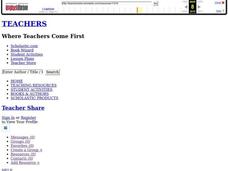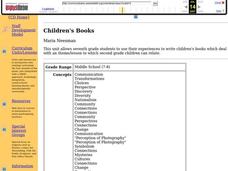Curated OER
Starfish
Students explore the concept of starfish. In this starfish lesson, students identify the parts of a starfish and how their body works. Students create a starfish using paint and a cornmeal mixture. They then glue on Cheerios to...
Curated OER
Water
Students conduct a series of investigations on the unique properties of water. In this general science lesson, students explain what causes water's surface tension. They explain the different stages in the water cycle.
Curated OER
Biology: Butterfly Activities
Second graders examine various types of butterflies and insects around their school. They identify differences between beetles and butterflies. Students examine books about butterflies, complete symmetry drawings, and make ladybug key...
Curated OER
Build A Model of the Water Cycle
Young scholars identify and describe the steps in the water cycle. They discover the sun as the source of the cycle. They work together to create their own water cycle model.
Curated OER
World Climate Growing Zones
Students create a map showing where crops would be grown around the world. In this crops lesson plan, students show how the world climate would produce different parts of the world at different times. Students fill out worksheets.
Curated OER
Where Does the Green Go?
Pupils investigate why green leaves change colors in the fall. They press leaves and write a poem, create a chlorophyll leaf print, take a nature walk, and create a leaf shape poster.
Curated OER
Fall vs. Spring
Students compare and contrast the seasons of fall and spring. In this fall and spring lesson plan, students learn the differences between fall and spring through books and pictures, identify the differences, draw their own pictures, and...
Curated OER
Who Will Benefit if We Give Bulbs What They Need to Grow?
Students identify the elements needed for bulbs to grow. They raise tulips and give them to various members of the community. They identify local philanthropic communities and look for ways they can constructively donate time and give...
Curated OER
Sea Scape
Learners learn about and make models of coral reefs. In this reef ecosystem lesson plan, the class locates a number of coral reefs on a map. They learn how a coral reef is a balanced ecosystem that depends upon all of it's plant and...
Curated OER
What is Photosynthesis?
Students study the plant process of photosynthesis through multiple activities. In this photosynthesis lesson, students make a graphic organizer, complete a science observation, and make a plant ID book to learn about the process of...
Curated OER
Build a Reef
Students build a coral reef, then discover organisms that make up the ecosystem.
Curated OER
What Do We Use From the Rainforest?
Young scholars identify items we use from the rainforest. For this earth science lesson, students recall prior facts about the rainforest and list items we use from the rainforest. Young scholars create "Rainforest Cookies" using...
Curated OER
The Timucua
Fifth graders identify characteristics of the Timucua Indian Tribe and explain how this tribe lived differently from the neighboring Calusa tribe. They create a triarama of a Timucua Indian village.
Curated OER
Fall vs. Spring
Students learn about fall and spring by engaging in hands-on activities in order to fulfill science and language arts standards. In this instructional activity on seasons, students first listen to a story about fall, discuss the...
Curated OER
Winter vs. Summer
Students explore the seasons. In this winter and summer instructional activity, students read The Snowy Day by Ezra Jack Keats and Summer by Maria Ruis. Students compare the 2 seasons as they create t-charts, try on seasonal clothing,...
Curated OER
Soil Sample Lab
Students test the pH of soil samples they collected from the field trip. In this chemistry lesson, students differentiate acids and bases. They write a lab report about the experiment.
Curated OER
Water Quality Monitoring
Students comprehend the four parameters of water quality. They perform tests for salinity, dissolved oxygen, pH and clarity or turbidity. Students comprehend why scientists and environmental managers monitor water uality and aquatic...
Curated OER
A Rainbow Under the Sea: How Do Animals Survive in the Ocean?
Second graders, with adult help, create a PowerPoint presentation on a selected ocean animal.
Curated OER
Science: A Tree for All Seasons
Students observe trees in their schoolyard and record the seasonal changes by drawing pictures. In this ongoing lesson, they discover the names of the seasons and place green paper leaves on a paper tree in the classroom, which are also...
Curated OER
Make a Dried Bouquet
Students examine how drying flowers was a popular hobby for Colonial women during the Colonial era in America. They read and discuss an instruction sheet, and create dried-flower bouquets that are hung upside down and tied with a string.
Curated OER
Children's Books
Students explore daily dilemmas students face. They write and illustrate a story book dealing with one dilemma. Students write reviews of their books. They read their books to second grade students. Additional cross curriculum activities...
Curated OER
Suitcase, Parfleche and 'Isaptakay
Third graders explore farfeche and how the Nez Perce people use natural materials to derive colors for their artwork. They explore traditional paints and dyes used by the Nez Perce and create their own parfleche 'isaptakay.























